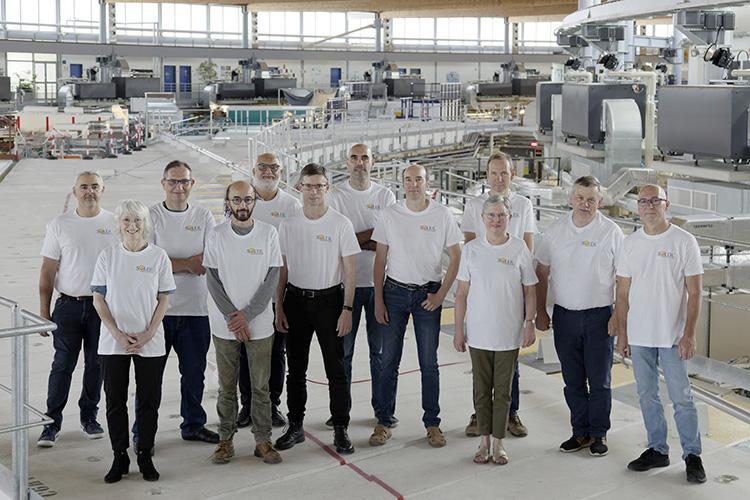To date, and over several successive years, the quality of its operation (beam availability, mean time between failures, mean time to recover) places SOLEIL in the top 3 synchrotrons in the world1. In addition to ensuring the day-to-day operation of the accelerators at such a high-performance level, SOLEIL's teams are working both on R&D projects associated with this operation and on projects to upgrade the synchrotron.
Amongst all these teams, the “Cristal collectif 2022” has distinguished SOLEIL/CNRS staff2 involved in these different technical achievements.
The excellent reliability of SOLEIL's accelerators is based on an extensive teamwork - to provide the beam to scientists, but also during technical interventions - as well as on a very rigorous organisation of the different types of maintenance and obsolescence management, and the skill maintenance of the staff involved. This is true in several fields: accelerator physics, magnetism, diagnostics, radiofrequency, electronics, computer science, mechanical and materials engineering, and vacuum technology.
The CNRS “Cristal collectif 2022” Prize was awarded to SOLEIL/CNRS staff from the "Accelerators and Engineering" division.
Innovative technical achievements
These achievements often present technological breakthroughs; this is the case of the new photon source for the ROCK beamline, which began to operate in August 2021: the Superbend, a new magnetic device made entirely of permanent magnets, which now provides the beamline with photon fluxes five times more intense. A technological feat presented here.
Another recent example is the so-called "Multipole Injection Kicker" (MIK) device designed and built by SOLEIL, then successfully commissioned in the MAX IV storage ring (Sweden) and more recently on SOLEIL. For more information.
Technology transfers
Some developments have led to the transfer of know-how and/or the acquisition of patents. This is the case of the so-called "solid state" power amplifiers, designed and developed by SOLEIL to replace the usual vacuum tubes (tetrodes, klystrons, etc.) whose role is to increase the energy of the electron beam. SOLEIL was the first synchrotron radiation source to use such amplifiers, which have now become must-haves elements in all projects to upgrade to new 4th generation synchrotrons.
As a result, SOLEIL has collaborated with several other synchrotrons (LNLS (Brazil), SLS (Switzerland)) and has concluded know-how transfers with two French companies: ELTA-AREVA and Sigmaphi ELECTRONICS.
Also designed and built mainly in-house at SOLEIL are the pulsed systems, electromagnets used to inject or extract electrons at the right time, without disturbing those already circulating in the accelerator. They must be able to be switched on and off very quickly and are therefore powered by electrical pulses lasting from a few hundred nanoseconds to a few milliseconds.
This development has led to a transfer of know-how to the French company Sigmaphi AIMANTS, which has won several contracts by proposing designs based on this technology.
Towards a 4th generation synchrotron
SOLEIL's 4th generation ring project aims to significantly reduce the natural emittance of the electron beam (from 4,000 pm.rad to 80 pm.rad) in order to produce light beams with a brilliance gain of up to two or three orders of magnitude.
Such a performance relies on several innovative and unprecedented developments, real technical challenges that are the subject of an intensive R&D program based on digital simulations, prototypes and measurements.
These developments include vacuum chambers with an internal diameter of only 10 mm (half that of the most recent ESRF-EBS, MAX IV or SIRIUS synchrotrons), the internal walls of which will be coated with a special layer (known as NEG, "Non Evaporable Getter"), the only possible solution for achieving in these chambers the vacuum necessary for the circulation of electrons under optimal conditions. Recent test measurements have validated this world first.
The SOLEIL upgrade project also aims to be environmentally friendly by making the use of permanent magnets the rule. Power consumption will be reduced by at least 50% and the breakdown risk will be decreased. Thus, a prototype permanent magnet quadrupole has already been produced with field gradients 6 times greater than the largest value currently in use.

Within the "Accelerators and Engineering" division, the SOLEIL/CNRS members making up the team awarded the CNRS Cristal collectif 2022 Prize are, from left to right:
Back: Rachid Ben El Fekih (power electronics); Dominique Corruble (electronics); Amor Nadji (Director of the division); Robert Lopes and Patrick Rommeluère, (electronics); Jean-Pierre Duval (vacuum).
In front: Marie-Agnès Tordeux (accelerator physics); Xavier El Attaoui, (computing); Olivier Marcouillé and Pascale Brunelle (accelerator physics); Christian Herbeaux (vacuum); Marc Ribbens (mechanics).
1- reports from the European Synchrotron Light Sources
2 - award attributed by the CNRS to "teams of men and women, research support staff, who have carried out projects whose technical mastery, collective dimension, applications, innovation and influence are particularly remarkable"; these teams must be made up of a maximum of 12 people; it was attributed to SOLEIL in the "direct research support" category.
